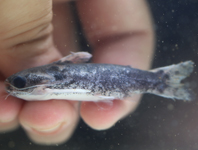Abstract
We provide data on the cytochrome c oxidase subunit I (COI) and 16S rDNA genes for eight species of common hard ticks in Xinjiang: Dermacentor montanus, D. niveus, Haemaphysalis sulcate, Hyalomma asiaticum asiaticum, Hya. detritum, Hya. scupense, Rhipicephalus sanguineus and R. pumilio. Genetic distances, calculated based on the Kimura two-parameter (K2P) distance model, found the same trend of intraspecies level≤interspecies level<intragenus level. Phylogenetic trees, constructed with the neighbor-joining (NJ) and minimum-evolution (ME) methods, demonstrated that each species clustered into separate clades, thus confirming the usefulness of CO1 and 16S rDNA genes for tick species identification. The genera Dermacentor, Haemaphysalis and Rhipicephalus were all recovered in the phylogenetic analysis, as was the subfamily Rhipicephalinae, but a monophyletic Hyalomma was not.
References
Banumathi, B., Vaseeharan, B., Rajasekar, P., Prabhu, N.M., Ramasamy, P., Murugan, K., Canale, A. & Benelli, G. (2017) Exploitation of chemical, herbal and nanoformulated acaricides to control the cattle tick, Rhipicephalus (Boophilus) microplus—A review. Veterinary Parasitology, 244, 102–110.
https://doi.org/10.1016/j.vetpar.2017.07.021
Barker, S.C. & Murrell, A. (2002) Phylogeny, evolution and historical zoogeography of ticks: A review of recent progress. Experimental and Applied Acarology, 28 (1–4), 55–68.
Black, W.C. 4th. & Piesman, J. (1994) Phylogeny of hard- and soft-tick taxa (Acari:Ixodida) based on mitochondrial 16S rDNA sequences. Proceedings of the National Academy of Sciences of the United States of America, 91 (21), 10034–10038.
Black, W.C. 4th., Klompen J.S. & Keirans, J.E. (1997) Phylogenetic relationships among tick subfamilies (Ixodida:Ixodidae:Argasidae) based on the 18S nuclear rDNA gene. Molecular Phylogenetics and Evolution, 7 (1), 129–144.
Bugmyrin, S.V., Belova, O.A., Bespyatova, L.A., Ieshko, E.P. & Karganova, G.G. (2016) Morphological features of Ixodes persulcatus and I. ricinus hybrids: nymphs and adults. Experimental and Applied Acarology, 69 (3), 359–369.
https://doi.org/10.1007/s10493-016-0036-3
Bush, L.M. & Vazquez-Pertejo, M.T. (2018) Tick borne illness-Lyme disease. Disease-a-Month, 64 (5), 195–212.
https://doi.org/10.1016/j.disamonth.2018.01.007
Chen, Z., Yang, X., Bu, F., Yang, X., Yang, X. & Liu, J. (2010) Ticks (Acari: Ixodoidea: Argasidae, Ixodidae) of China. Experimental and Applied Acarology, 51 (4), 393–404.
https://doi.org/10.1007/s10493-010-9335-2
Du, J., Mu, L., Zhang, L., Wang, L., Wang, A. & Zhang, K. (2015) Morphological classification and molecular identification of in Yining County, Xinjiang Uygur Autonomous Region, China. Chinese Journal of Vector Biology and Control, 26 (3), 271–274.
Ernieenor, F.C.L., Ernna, G. & Mariana, A. (2017) Phenotypic and genotypic identification of hard ticks of the genus Haemaphysalis (Acari: Ixodidae) in Peninsular Malaysia. Experimental and Applied Acarology, 71 (4), 387–400.
https://doi.org/10.1007/s10493-017-0120-3
Gou, H., Xue, H., Yin, H., Luo, J. & Sun, X. (2018) Molecular Characterization of Hard Ticks by Cytochrome c Oxidase Subunit 1 Sequences. Korean Journal of Parasitology, 56 (6), 583–588.
https://doi.org/10.3347/kjp.2018.56.6.583
Gray, J.S., Estrada-Peña, A. & Zintl, A. (2019) Vectors of Babesiosis. Annual Review of Entomology, 64, 149–165.
https://doi.org/10.1146/annurev-ento-011118-111932
Guo, R., Shen, S., Zhang, Y., Shi, J., Su, Z., Liu, D., Liu, J., Yang, J., Wang, Q., Hu, Z., Zhang, Y. & Deng, F. (2017) A new strain of Crimean-Congo hemorrhagic fever virus isolated from Xinjiang, China. Virologica Sinica, 32 (1), 80–88.
https://doi.org/10.1007/s12250-016-3936-9
Ismail, N. & McBride, J.W. (2017) Tick-Borne emerging infections: ehrlichiosis and anaplasmosis. Clinics in Laboratory Medicine, 37 (2), 317–340.
https://doi.org/10.1016/j.cll.2017.01.006
Jongejan, F. & Uilenberg, G. (2004) The global importance of ticks. Parasitology, 129 (Supplement), S3–S14.
Klompen, J.S., Black, W.C., Keirans, J.E. & Oliver, J.H. Jr. (1996) Evolution of ticks. Annual Review of Entomology, 41, 141–161.
Li, H.Y., Zhao, S.S., Hornok, S., Farkas, R., Guo, L.P., Chen, C.F., Shao, R.F., Lv, J.Z. & Wang, Y.Z. (2017) Morphological and molecular divergence of Rhipicephalus turanicus tick from Albania and China. Experimental and Applied Acarology, 73 (3–4), 493–499.
https://doi.org/10.1007/s10493-017-0189-8
Lv, J., Wu, S., Zhang, Y., Chen, Y., Feng, C., Yuan, X., Jia, G., Deng, J., Wang, C., Wang, Q., Mei, L. & Lin, X. (2014) Assessment of four DNA fragments (COI, 16S rDNA, ITS2, 12S rDNA) for species identification of the Ixodida (Acari: Ixodida). Parasites & Vectors, 7, 93.
https://doi.org/10.1186/1756-3305-7-93
McCoy, K.D., Léger, E. & Dietrich, M. (2013) Host specialization in ticks and transmission of tick-borne diseases: a review. Frontiers in Cellular and Infection Microbiology, 3, 57.
https://doi.org/10.3389/fcimb.2013.00057
McFee, R.B. (2018) Tick borne illness—Rocky mountain spotted fever. Disease-a-Month, 64 (5), 185–194.
https://doi.org/10.1016/j.disamonth.2018.01.006
Murrell, A., Campbell, N.J. & Barker, S.C. (2000) Phylogenetic analyses of the Rhipicephaline ticks indicate that the genus Rhipicephalus is paraphyletic. Molecular Phylogenetics and Evolution, 16 (1), 1–7.
Ondrejicka, D.A., Morey, K.C. & Hanner, R.H. (2017) DNA barcodes identify medically important tick species in Canada. Genome, 60 (1), 74–84.
https://doi.org/10.1139/gen-2015-0179
Ruzek, D., Avšič Županc, T., Borde, J., Chrdle, A., Eyer, L., Karganova, G., Kholodilov, I., Knap, N., Kozlovskaya, L., Matveev, A., Miller, A.D., Osolodkin, D.I., Överby, A.K., Tikunova, N., Tkachev, S. & Zajkowska, J. (2019) Tick-borne encephalitis in Europe and Russia: Review of pathogenesis, clinical features, therapy, and vaccines. Antiviral Research, 164, 23–51.
https://doi.org/10.1016/j.antiviral.2019.01.014
Wang, Y.Z., Mu, L.M., Zhang, K., Yang, M.H., Zhang, L., Du, J.Y., Liu, Z.Q., Li, Y.X., Lu, W.H., Chen, C.F., Wang, Y., Chen, R.G., Xu, J., Yuan, L., Zhang, W.J., Zuo, W.Z. & Shao, R.F. (2015) A broad-range survey of ticks from livestock in Northern Xinjiang: changes in tick distribution and the isolation of Borrelia burgdorferi sensu stricto. Parasites & Vectors, 8, 449.
https://doi.org/10.1186/s13071-015-1021-0
Wu, X.B., Na, R.H., Wei, S.S., Zhu, J.S. & Peng, H.J. (2013) Distribution of tick-borne diseases in China. Parasites & Vectors, 6, 119.
https://doi.org/10.1186/1756-3305-6-119
Yu, X., Ye, R.Y. & Gong, Z.D. (1997) The Ticks Fauna of Xinjiang. Xinjiang Scientific, Technological and Medical Publishing House, Urumqi, Xinjiang, 169 pp.
Zhang, R.L. & Zhang, B. (2014) Prospects of using DNA barcoding for species identification and evaluation of the accuracy of sequence databases for ticks (Acari: Ixodida). Ticks and Tick-Borne Diseases, 5 (3), 352–358.
https://doi.org/10.1016/j.ttbdis.2014.01.001
Zhang, Y., Shen, S., Fang, Y., Liu, J., Su, Z., Liang, J., Zhang, Z., Wu, Q., Wang, C., Abudurexiti, A., Hu, Z., Zhang, Y. & Deng, F. (2018) Isolation, Characterization, and Phylogenetic Analysis of Two New Crimean-Congo Hemorrhagic Fever Virus Strains from the Northern Region of Xinjiang Province, China. Virologica Sinica, 33 (1), 74–86.
https://doi.org/10.1007/s12250-018-0020-7


